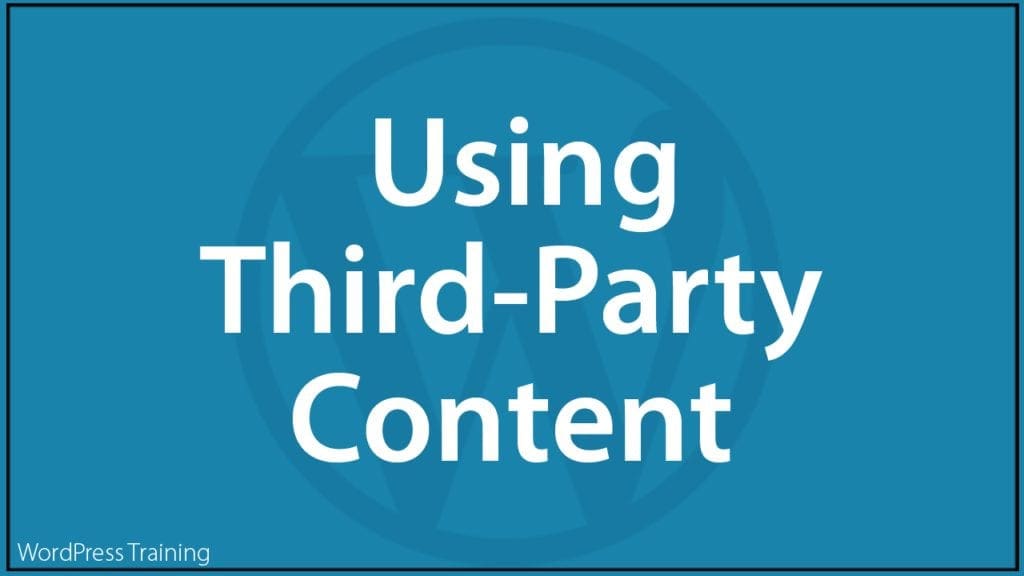Content Marketing With WordPress – Using Third-Party Content

This tutorial is part of our series on using content marketing to create more exposure online for your business and drive more traffic to your site.
Subscribe to our web content creation course and learn how to never run out of great content for your website, blog, or newsletter.
***
In this tutorial series, we explore ways to repurpose content and the dos and don’ts of using third-party content.
We also recommend the tutorials below for additional information:
- Rewriting Content
- Using Content Writing Tools
- Using Content Rewriting Tools
- Using Ready-Made Content
***
Including third-party content (i.e. created by someone else) as part of your own content mix can save you time in your content creation process.
Here are just some examples of third-party content you may want to consider using:
- Private Label Rights content (to save time writing the content yourself),
- Quoting someone verbatim or referencing sections of text from another site (e.g. publishing research findings, definitions of terms, etc.)
- Publishing products or service descriptions, summaries, etc.
- Publishing news items, industry updates, etc.
- Creating training content about third-party products or services,
- etc.
Creating Unique Content Is Challenging
Whenever possible, you should definitely aim to publish high-quality unique content targeted to your audience and publish often if you want to improve your results.
The challenge, however, is that creating high-quality, original, and unique content on a regular basis can be very time-consuming and expensive, especially if you are a small business.
Many small businesses outsource the creation and management of their website.
But what about outsourcing the creation and management of their content?
A good content marketing strategy involves planning, research, information gathering, writing, editing, having subject expertise and an understanding of the business (i.e. its vision, mission, values, objectives, products, etc.), and more.
According to SEO and digital marketing experts, your content marketing strategy should include things like:
- Always publish 100% original and unique content on your site to avoid being penalized for duplicate content by Google.
- Make sure the content is search optimized to improve rankings and traffic.
- Publish content regularly on your website, social media, newsletters, etc. to grow your presence online, expand your reach, attract more prospects, and keep your audience engaged.
Implementing the above guidelines is quite challenging.
For example, if your monthly content marketing strategy involves publishing articles on your site 2-3 times a week, posting content to social media on a regular basis, maintaining a newsletter, etc. how much content will you need to create every month?
And who is going to do this? Who is going to sit down and actually write this content for you?

You may think that outsourcing your content to a freelance writer is the answer.
Outsourcing has its own challenges. You need to develop a content writing plan and guidelines, find, hire, and train your writer, then manage the outsourcing process itself.
Depending on your budget and who you hire to write for you, you will probably find that the articles you receive from your freelance writer will not be as substantial as you had hoped for.
Creating unique, original content that has depth, substance, and reflects expertise in your business or niche can take hours or days to write.
This is the challenge of following the advice of SEO experts. Publishing high-quality, unique, and original content may not always be practical or doable.
For this reason, our tutorials follow a practical approach to creating and publishing content that is unique enough and good enough to help get your online presence established.
For example, no matter which industry you’re in, you can subscribe to receive newsletters and marketing information from related services (other companies, competitors, etc).
This helps you leverage your research. You can glean ideas from this information and use the methods covered in our tutorials to rewrite, compile, expand upon, and repurpose this content into new articles with a different perspective or a unique angle.
You can then publish these articles on your website or blog, and create summaries and excerpts of your articles and post these on social media with links pointing back to your site, add these snippets to newsletters, etc.
This simple strategy can be executed quite quickly and inexpensively and will help you create and publish content that is original and unique enough to get your business out there.
As you develop a regular habit of publishing content online, you will then find the right way to mix original, rewritten, and repurposed content to promote your business or website across various different channels.
Anyone can do this, regardless of their budget and/or limited time and resources, and set themselves apart from their competition.
With this approach in mind, let’s now help you become aware of all the different methods you can use to turn information into great content that will help you improve your results online.
Click on a tutorial below to continue:
- Rewriting Content
- Using Content Writing Tools
- Using Content Rewriting Tools
- Using Ready-Made Content

For additional tutorials on ways to create content for your website, go here: Content Marketing With WordPress
***
Updated: July 5th, 2024

